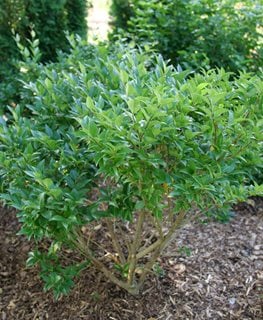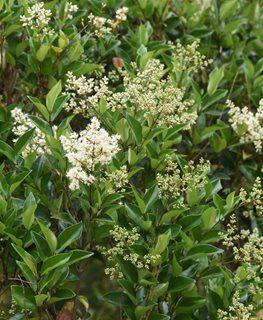HOW TO GROW AND CARE FOR PRIVET (LIGUSTRUM)
Use this fast-growing shrub as hedging or screening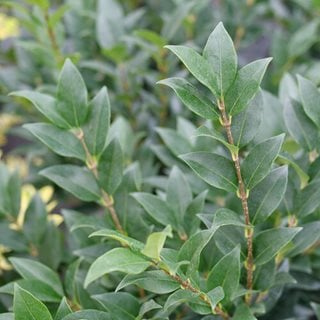
Kindly™ privet. Photo: Proven Winners
Do you need a quick solution to create privacy in your yard? Privet is popular landscape plant commonly used as hedging or screening. These shrubs or small trees have a rapid growth rate, making them useful for quickly blocking out an unsightly view or creating privacy screening. Privet tolerates a range of growing conditions, can withstand salt and urban pollution, and needs little maintenance other than regular pruning to keep it under control.
A member of the olive family (Oleaceae), there are over 50 species of Ligustrum native to Asia, Europe and Africa. Some species such as Chinese privet and Japanese privet can be highly invasive in certain regions, particularly the Deep South, so extreme caution should be taken when selecting and growing privet in your landscape. Newer cultivars are bred to be sterile and non-invasive, and are a better alternative where privet is a problem. Here’s how to grow and use privet in your yard.
On this page: Basics | Planting | Care | Varieties | Frequently Asked Questions | Landscaping Ideas
On this page:
PRIVET BASICS
Botanical name:
Ligustrum
Common names:
Common names such as waxleaf privet and common privet are used interchangeably between some species.
Plant type:
Deciduous, semi-evergreen, or evergreen shrub or small tree
Zones:
3-10, depending on the species
Exposure:
Full sun to part shade
Habit:
Upright bushy habit
Height/Spread:
4 to 10 feet tall, 4 to 20 feet wide
Bloom time:
Spring to summer
Flowers:
Small white flowers with 4 petals occur on conical or irregularly shaped clusters. The blooms are a nectar source for honey bees, butterflies, and other insect pollinators. Flowers exude a strong, sweet fragrance some people enjoy and others find unpleasant. Additionally, many people are allergic to privet pollen, causing asthma or respiratory distress.
Berries:
Clusters of small round berries follow the flowers. The dark purple or black fruits, sometimes called drupes, have a shiny sheen. Berries may persist into winter, and are a food source for songbirds. Birds contribute to the invasiveness of some privet species by distributing the seeds.
Foliage:
Glossy oval or pointed leaves come in different sizes, with green, gold, or variegated coloring. Foliage can be deciduous, semi-evergreen, or evergreen. Foliage can also cause a rashlike reaction or hives in many people.
HOW TO PLANT PRIVET
When to plant:
Plant privet bushes during milder months in spring or fall to avoid stress from extreme hot or cold temperatures.
Where to plant:
Privet will do best in a site that receives full sun to partial shade. Provide well-drained soil to prevent root rot.
How to plant:
Loosen soil in the planting area and amend with compost or other rich organic matter, making sure the soil is well draining. Dig a hole twice as wide and slightly shallower than the root ball. Remove the plant from its nursery pot and gently loosen the roots if they are tightly bound. Place privet plant in the hole so the top of the root ball is slightly above the surrounding soil. Fill in soil around the root ball and gently tamp down to remove air pockets. Water plants well. Space plants 1 to 2 feet apart or more, depending on the variety.
PRIVET CARE
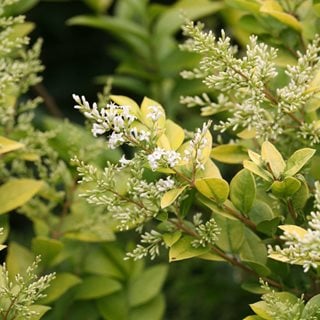
Golden Ticket® privet. Photo: Proven Winners
Soil:
Ligustrum are tolerant of different soil types as long as there is good drainage. They do best in amended soil with a pH of 6 to 8. Plants are somewhat tolerant of salt, making them a good choice for beachside locations or near roadways that get salted in winter.
Fertilizer:
In early spring, apply a slow-release granular fertilizer especially formulated for trees and shrubs according to package instructions.
Watering:
Ligustrum perform best with moderate moisture and are drought tolerant once established. Provide supplemental water during prolonged heat and dry spells as needed and don’t allow soil to dry out completely. Avoid overwatering to prevent root rot or other diseases.
Pruning:
Ligustrum is fast growing, producing 1 to 2 feet of new growth each year. Plants are amenable to heavy pruning and shearing and need regular pruning to keep them in check, especially if used as formal hedging or topiaries. When cutting back privet, wait until plants have finished flowering and lightly prune as needed during the summer to promote more branching and dense growth.
Pests and diseases:
When grown in the right conditions, privet is resistant to pests and diseases. Pests include aphids, leaf miners, mealybugs, mites, scale, thrips, weevils, and whiteflies. Diseases include anthracnose, leaf spot, powdery mildew, root rot, twig blight, and wilt.
Is privet deer resistant?
Privet is considered deer resistant, though deer will graze on almost any plant if they are hungry enough.
Is privet toxic?
Ligustrum leaves and berries contain glycosides, a compound that can cause mild to moderate distress in humans, pets, and livestock if ingested. Contact your doctor, veterinarian, or poison control if you suspect your children or pets have ingested this plant.
PRIVET VARIETIES
FREQUENTLY ASKED QUESTIONS
Are privets evergreen?
Ligustrum can be deciduous, semi-evergreen or evergreen, depending on the species and growing region.
How invasive is privet?
Privet shrubs can be somewhat to highly invasive, depending on the species and growing region. Newer varieties have been bred to be sterile and non-invasive.
Is privet toxic to dogs?
The leaves and berries of privet shrubs are mildly to moderately toxic to dogs if ingested.
Where is the best place to plant ligustrum?
Provide a site that receives full sun to partial shade with well-draining soil.
PRIVET LANDSCAPING TIPS
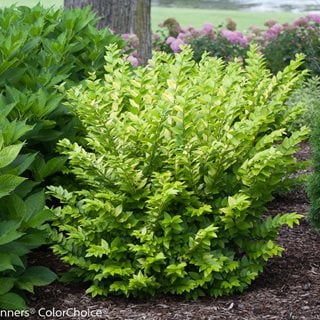
Golden Ticket® privet. Photo: Proven Winners
For borders and landscapes:
Privet can be used as hedging, privacy screening, and in mass plantings. Use smaller varieties with decorative foliage as a focal point in the landscape.
For slopes and hillsides:
Mass privet plants along a slope or hillside to help stem erosion.
For containers:
Due to its larger mature size and rapid growth rate, privet is not recommended to be grown in containers.
There are many ways to use privet in your landscape. Here’s how:
- Plant a privet hedge along a property line to create privacy.
- Use a medium-sized privet as hedging to separate garden areas.
- Add a small to medium-sized variety with variegated or gold foliage to a mixed border as a background plant.
- Combine a small to medium-sized variety in a foundation planting with other shrubs with different foliage color and bloom times for season-long interest.
- Mass privet along a steep slope or hillside for erosion control.
- Use a variegated or gold-leafed variety to brighten up a darker area of your yard.
- Prune a single specimen into a small tree or topiary for a focal point in the landscape.
- Use a tall privet hedge as a wind break on a larger property.
Note: Depending on the variety, privet shrubs can be quite messy with flower, fruit, and leaf drop.
Companion plants: Other shrubs that go with privet include abelia, arborvitae, boxwood, euonymus, false cypress, hibiscus, holly, juniper, mahonia, quince, and roses. Perennial companions include agapanthus, hosta, lady’s mantle, ornamental grasses, peony, and sedum.
Privet alternatives: In areas where privet is invasive, grow sterile cultivars or other shrubs with similar growing needs instead. These may include aronia, highbush blueberry, holly, mountain laurel, pieris, red twig dogwood, sumac, viburnum, or winterberry.
RELATED:
Invasive Plants
17 Fast-Growing Shrubs for Your Garden
Low-Maintenance Shrubs for Your Garden
16 Best Flowering Shrubs




